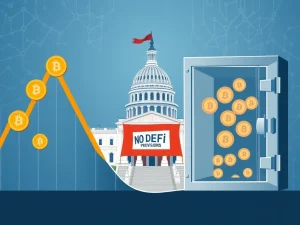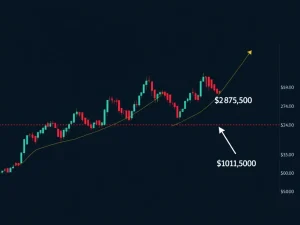Unlocking the Future: Top 10 **Fastest-Growing Blockchains** by Active Users in 2025

The cryptocurrency landscape constantly evolves. Many new networks emerge to challenge established leaders. But are these platforms truly gaining widespread use? In 2025, blockchain growth has been driven by real user engagement and innovative technology. This is not just speculation. From foundational Layer-1 blockchains to efficient Layer-2 solutions, networks compete fiercely. They aim to attract millions of active crypto users. They offer low-cost transactions and seamless integrations. Their thriving decentralized finance (DeFi) and non-fungible token (NFT) ecosystems also attract users. This article ranks the top 10 fastest-growing blockchains based on their active user growth. We highlight their drivers and challenges.
Understanding Blockchain Growth and Key Metrics
Evaluating blockchain growth requires clear criteria. Our ranking of the top 10 fastest-growing blockchains of 2025 relies primarily on active user numbers. Each entry details whether the network is a Layer 1 (L1) or Layer 2 (L2) solution. Furthermore, we examine the specific metrics supporting its rise. We also analyze the main drivers behind its expansion. Finally, we address the unique challenges each platform faces. For instance, L1 blockchains provide foundational infrastructure. They feature native consensus mechanisms. Conversely, L2 solutions enhance the scalability of L1 blockchains. They also significantly reduce transaction costs. Ethereum, for example, is an L1 blockchain. Polygon, on the other hand, functions as an L2.
What Defines Active Crypto Users?
The term “active crypto users” specifically refers to a unique wallet address. This address completes at least one transaction within a given period. This metric offers a reliable gauge of real-world adoption. Another important metric is Fully Diluted Valuation (FDV). FDV represents the theoretical total market value of a cryptocurrency. This assumes all its tokens are in circulation at the current price. Consequently, FDV provides a broader view of a project’s potential value. It helps determine if a token is overvalued or undervalued. This is relative to its total potential supply. Understanding these metrics is crucial for assessing true crypto adoption.
Discovering the Fastest-Growing Blockchains of 2025
Here are the networks demonstrating remarkable blockchain growth in 2025:
1. Solana: A High-Speed Powerhouse
Solana stands as a high-speed L1 blockchain. It utilizes a proof-of-history (PoH) consensus mechanism. It is specifically designed for scalable decentralized applications (DApps) and marketplaces.
- Monthly Active Users: 57 million
- FDV: $107.2 million
- Token Trading Volume (30 days): $284.2 billion
Key drivers: Solana’s expansion stems from its robust DeFi and NFT sectors. A surge in high-frequency memecoin trading also contributes significantly. The Firedancer validator client has boosted reliability. Moreover, increasing institutional adoption further fuels its rise. This network consistently attracts a massive base of active crypto users.
Challenges: Past network outages have affected reliability. Critics also raise concerns regarding its degree of centralization. Furthermore, competition from L2 solutions presents an ongoing challenge. Despite these hurdles, Solana remains a leader among the fastest-growing blockchains.
2. Near Protocol: Bridging AI and Blockchain
Near Protocol is an L1 blockchain employing a thresholded proof-of-stake (TPoS) consensus. It prioritizes scalability, developer-friendly tools, and AI-native features for decentralized applications.
- Active Addresses (Monthly): 51.2 million
- FDV: $3.1 million
- Token Trading Volume (30 days): $7.8 million
Key drivers: Its AI integration for user-owned agents and intents is a major draw. Low transaction fees coupled with carbon neutrality also appeal to users. Partnerships, such as with EigenLayer for fast finality, enhance its capabilities. Ecosystem expansions in DeFi and gaming further bolster its position. Near is a strong contender among top blockchains 2025.
Challenges: Near faces stiff competition from faster L1s and L2s. Price volatility persists despite strong user growth. Potential vulnerabilities related to sharding complexity also pose risks. However, its innovation continues to drive blockchain growth.
3. BNB Chain: Binance’s Robust Ecosystem
BNB Chain is a Binance-backed L1 blockchain. It supports DeFi, NFTs, and DApps. It also offers Ethereum Virtual Machine (EVM) compatibility.
- Active Addresses (Monthly): 46.4 million
- FDV: $121.2 billion
- Token Trading Volume (30 days): $56.1 billion
Key drivers: A reduced block time to 0.75 seconds significantly improves efficiency. AI integrations for data ownership are also gaining traction. These factors contribute to its impressive blockchain growth. This makes it a significant player for active crypto users.
Challenges: Concerns regarding centralization due to Binance’s backing remain. Regulatory scrutiny also poses a constant threat. Nevertheless, BNB Chain maintains a strong market presence.
4. Base: Coinbase’s Layer-2 Innovation
Coinbase developed Base, an Ethereum L2 blockchain. It utilizes optimistic rollups. Base focuses on low-cost DeFi, consumer apps, and seamless integration.
- Active Addresses (Monthly): 21.5 million
- FDV: $2.92 billion
Key drivers: Ultra-low fees, averaging $0.01, attract many users. Coinbase’s vast user base, exceeding 100 million, provides a massive onboarding funnel. Stablecoin flows and partnerships for consumer DApps further drive its adoption. Base exemplifies successful crypto adoption strategies.
Challenges: Network congestion from high activity can occur. Dependence on Ethereum for security is inherent. Regulatory compliance as a newer ecosystem also presents ongoing challenges. Base is quickly becoming one of the fastest-growing blockchains.
5. Tron: Stablecoin and Content Hub
Tron is a high-throughput L1 blockchain. It focuses on decentralized content sharing and Telegram integration. It particularly emphasizes low-cost stablecoin transactions.
- Active Addresses (Monthly): 14.4 million
- FDV: $33.5 billion
- Token Trading Volume (30 days): $51.7 billion
Key drivers: Negligible transaction fees are a primary attraction. AI and cross-chain integrations enhance its utility. Partnerships, such as with Rumble Cloud, expand its reach. This solidifies its position among top blockchains 2025.
Challenges: Tron faces ongoing regulatory scrutiny. Centralization risks are also frequently cited. Despite these, it remains a significant platform for active crypto users.
6. Bitcoin: The Original Digital Gold
Bitcoin remains the original decentralized cryptocurrency. It uses proof-of-work (PoW) consensus. It primarily serves as digital gold for store-of-value and payments.
- Active Addresses (Monthly): 10.8 million
- FDV: $2.3 trillion
- Token Trading Volume (30 days): $1.3 trillion
Key drivers: Institutional inflows via exchange-traded funds (ETFs) are a significant factor. As of Q4 2024, professional investors with over $100 million under management hold Bitcoin ETFs worth $27.4 billion. Reduced supply due to halving events also boosts its value. Its adoption as a strategic reserve continues to grow. This demonstrates its enduring appeal and impact on overall blockchain growth.
Challenges: High energy consumption remains a concern. Volatility from macroeconomic factors also impacts its price. Nevertheless, Bitcoin’s fundamental role in crypto adoption is undeniable.
7. Aptos: Next-Gen Scalability with Move
Aptos is an L1 blockchain. Former Meta engineers developed it using the Move language. It emphasizes scalability, DeFi, and developer growth for DApps.
- Active Addresses (Monthly): 10 million
- FDV: $5.3 billion
- Token Trading Volume (30 days): $13 billion
Key drivers: It boasts peak transaction speeds of 19,200 TPS. The Move language ensures secure smart contracts. Partnerships, like Tether’s USDt (USDT) launch, expand its ecosystem. This positions it as one of the fastest-growing blockchains.
Challenges: Aptos needs broader adoption to compete effectively. Competition from established L1s also presents a hurdle. Nevertheless, its technological prowess makes it a strong contender among top blockchains 2025.
8. Ethereum: The Smart Contract Pioneer
Ethereum stands as a leading L1 blockchain. It is foundational for smart contracts, DeFi, and NFTs. It features a vast developer ecosystem and uses a proof-of-stake (PoS) consensus.
- Active Addresses (Monthly): 9.6 million
- FDV: $522.7 billion
- Token Trading Volume (30 days): $1.1 trillion
Key drivers: The Pectra upgrade promises better user experience (UX) and scalability. ETF inflows and institutional staking further solidify its position. Ethereum’s enduring innovation continues to attract active crypto users.
Challenges: Scalability issues persist despite upgrades. Higher fees compared to rivals remain a concern. Regulatory pressures also present ongoing challenges. However, its ecosystem continues to drive blockchain growth.
9. Polygon: Ethereum’s Scaling Companion
Polygon offers a multichain scaling solution for Ethereum. It uses PoS and supports DeFi, NFTs, and enterprise applications with EVM compatibility.
- Active Addresses (Monthly): 7.2 million
- FDV: $2.6 billion
- Token Trading Volume (30 days): $4.2 billion
Key drivers: Upgrades like Heimdall v2 enhance interoperability. Partnerships with Fortune 500 firms boost its enterprise adoption. These efforts contribute significantly to its blockchain growth. This makes it a key player for crypto adoption.
Challenges: Regulatory scrutiny under Markets in Crypto-Assets (MiCA) is a concern. Competition from other L2s also remains intense. Polygon’s role as a multichain scaling hub is still vital.
10. Arbitrum One: Leading Ethereum Layer-2
Arbitrum One is a prominent Ethereum L2 solution. It uses optimistic rollups for faster, cheaper transactions. It inherently inherits Ethereum’s robust security.
- Active Addresses (Monthly): 4 million
- FDV: $5.1 billion
- Token Trading Volume (30 days): $14.3 billion
Key drivers: Integrations, such as with Robinhood for tokenized assets, expand its reach. Upgrades like Stylus further reduce fees. These developments attract more active crypto users. Arbitrum One is certainly among the fastest-growing blockchains.
Challenges: Its dependence on the Ethereum mainnet is a core aspect. Regulatory uncertainty also poses a risk. Furthermore, competition from Optimism is a constant factor. Yet, it continues to demonstrate strong performance.
Key Trends Driving Widespread Crypto Adoption
The story of blockchain in 2025 is one of accelerating innovation. New technologies and mainstream acceptance are pushing growth. This occurs on both foundational L1 and scaling L2 layers. Several noticeable trends fuel this expansion and contribute to overall crypto adoption:
- Stablecoin Adoption Boosting Transaction Volumes: Stablecoins like USDT and USDC are significantly increasing transaction activity. This enhances liquidity and user engagement across various ecosystems. They provide a stable medium for transactions.
- Layer-2 Solutions Enhancing Scalability and Reducing Costs: Scaling solutions, including Arbitrum One and Base, vastly improve Ethereum’s transaction capacity. They also lower fees to as little as $0.01 per transaction. This makes DApps more affordable and accessible for everyday users.
- DeFi and NFT Ecosystems Attracting New Users: Decentralized finance protocols and NFT marketplaces continue to onboard millions of new users. Services like GMX on Arbitrum and Polygon’s substantial NFT volume ($227 million in Q1 2025) offer innovative tools. They transform finance and digital collectibles.
- Integration with Mainstream Platforms: Blockchains are growing through strategic integrations with major platforms. For instance, Base is built directly into Coinbase. This provides access to over 100 million potential users. Such integrations bridge the gap between crypto and traditional finance.
- Institutional Interest and Partnerships: Growing institutional involvement legitimizes blockchain technology. Bitcoin ETFs received $36.4 billion in 2024, signaling strong professional investor confidence. Corporate partnerships further enhance credibility. Starbucks, for example, partnered with Microsoft and Azure blockchain to create a traceability system. This broadens the scope of blockchain growth.
Navigating Challenges for Sustainable Blockchain Growth
The rapid growth of the top blockchains 2025 by active users highlights decentralized technology’s expanding role. Networks like Solana and Arbitrum lead this adoption. They offer low-cost transactions, DeFi applications, and mainstream integrations. However, key challenges persist. Addressing these is crucial for sustainable blockchain growth:
- Inflated Metrics: Bot activity and inactive addresses can exaggerate true user growth. This makes accurate assessment difficult.
- Scalability vs. Decentralization: Some high-speed networks may compromise on decentralization to achieve higher throughput. This trade-off is a constant debate.
- Regulatory Uncertainty: Scrutiny of stablecoins and concerns over illicit activities create adoption risks. Clearer regulations are still needed.
- Market Competition: Intense rivalry exists between L1 chains and Ethereum’s L2 solutions. This competition drives innovation but also fragments the market.
In response, blockchains are continuously innovating. They develop better bot detection mechanisms. They also improve scaling solutions and prioritize regulatory compliance. Furthermore, they offer unique value propositions like AI integration and asset tokenization. These efforts are crucial for sustaining long-term growth. Ultimately, they will shape the future of the entire ecosystem.
Conclusion: The Future of Active Crypto Users
The year 2025 showcases a dynamic period for blockchain technology. Real-world utility and increasing active crypto users define this era. The fastest-growing blockchains demonstrate resilience and adaptability. They navigate a complex landscape of technological advancements and market demands. As these networks mature, their ability to overcome challenges will determine their lasting impact. The ongoing push for innovation promises a future where blockchain technology is even more integrated into our digital lives. This paves the way for unprecedented crypto adoption globally.









